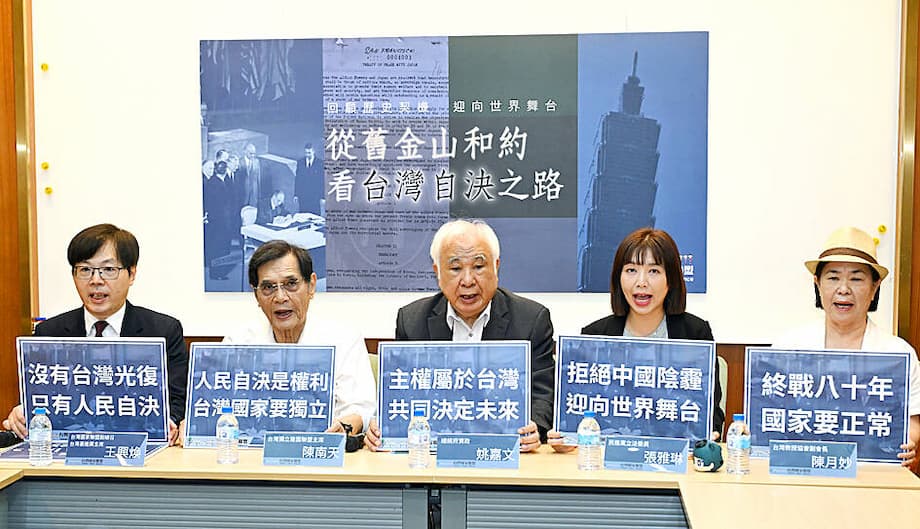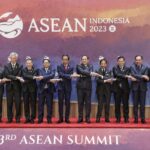Beijing clashes with Taipei over postwar documents and Taiwan status
China has restated that Taiwan is part of its territory, dismissing the San Francisco Peace Treaty as illegal and invalid. The latest remarks from Foreign Ministry spokesperson Mao Ning came after a Taiwan regional official argued that the treaty replaced the wartime Cairo Declaration and Potsdam Proclamation and did not place Taiwan under the jurisdiction of the People’s Republic of China (PRC). Beijing framed the Taiwan official’s comments as a distortion of history and an attempt to advance a Taiwan independence agenda, while insisting that the world accepts the one China principle as the basis for diplomatic relations with China.
- Beijing clashes with Taipei over postwar documents and Taiwan status
- What is the San Francisco Treaty and what did it say
- Beijing’s legal case
- Taipei’s position and local voices
- How Washington reads the issue
- Beyond Taiwan, the San Francisco System debate
- European comments and Beijing’s response
- What international law can and cannot resolve
- Why the dispute is heating up now
- What to Know
At a regular press briefing in Beijing, Mao tied Taiwan’s status to the Allied victory over Japan in 1945 and to a series of wartime and surrender documents that, in China’s reading, confirmed the recovery of Taiwan to China. She argued that the PRC, founded in 1949, is the sole legal government of China and therefore holds full sovereignty that includes Taiwan. In her words, the change that took place in 1949 was a change of government within the same international legal entity, not a change of sovereignty or territory.
The spokesperson also pushed back at criticism from European figures who say Beijing is unilaterally changing the status quo in the Taiwan Strait and in maritime disputes. Mao said the Taiwan question is an internal matter for China and asserted that the situation in the East and South China Seas remains generally stable. She urged outside parties to support regional dialogue and avoid steps that fuel confrontation.
What is the San Francisco Treaty and what did it say
The San Francisco Peace Treaty was signed on September 8, 1951 and entered into force on April 28, 1952. It formally ended the state of war between Japan and most Allied powers. Japan renounced claims to Taiwan and the Penghu Islands, but the treaty did not name a recipient state for those territories. Neither the PRC nor the Republic of China (ROC) on Taiwan was invited to the conference. On the same day the treaty took effect, Japan signed a separate peace with the ROC. Scholars commonly use the term San Francisco System to describe the network of defense treaties and arrangements forged around Japan and the United States after the treaty took effect, which shaped the security order in the Western Pacific for decades. For context on how Beijing challenges that framework, see analysis by The Diplomat at this link.
For many in Taiwan who support formal independence, the San Francisco Treaty left Taiwan’s legal status undecided because it did not assign sovereignty to any state. Activists and some political parties in Taipei have urged school curricula to reflect that interpretation, arguing that a wartime assumption of ROC control in 1945 did not constitute a definitive legal transfer of sovereignty. Those groups also contest the legal weight of the wartime declarations cited by Beijing, calling the Cairo text a press statement of intent rather than a binding treaty.
Beijing’s legal case
China’s position rests on a chain of wartime and surrender documents and on its claim of continuity of the Chinese state before and after 1949. The Cairo Declaration of 1943 stated that territories taken by Japan from China, including Taiwan and the Penghu Islands, would be restored to China. The Potsdam Proclamation of 1945 required Japan’s unconditional surrender and directed that the terms of Cairo would be carried out. Japan accepted those terms in the Instrument of Surrender later that year. Beijing argues these texts, read together with the surrender ceremony in Taipei in 1945, established that Taiwan had returned to China, and that this outcome is part of the postwar international order. The PRC’s 2022 white paper on the Taiwan question sets out this view in detail and states that peaceful reunification under One Country, Two Systems remains the preferred route to settle the question. The document is available at the Chinese embassy site at this link.
Mao Ning underscored the claim that the founding of the PRC did not alter sovereignty. She said the PRC is the only legal government representing China and that it naturally exercises the full range of China’s sovereign rights, including those pertaining to Taiwan. She also argued that the international community widely recognizes the one China principle and that attempts to promote Taiwan independence undermine stability across the strait.
Beijing also rejects the San Francisco Peace Treaty as a basis for deciding Taiwan’s status because China was excluded from the 1951 conference. Chinese officials have long argued that a settlement of issues affecting Chinese territory without China’s participation is illegal and void. As a matter of history, this stance dates back to a statement by Foreign Minister Zhou Enlai in August 1951 and it remains a consistent theme in official discourse today. The Diplomat notes that Chinese rhetoric also links the San Francisco System to the later stationing of United States forces in Japan and a wider alliance network in the Western Pacific.
Taipei’s position and local voices
The government on Taiwan presents a very different account. It says the PRC has never exercised sovereignty over Taiwan and that the ROC has maintained effective control over Taiwan and several outlying islands since 1949. The official history portal states that Taiwan and China have been ruled by different governments since the Chinese civil war, and that the ROC government began exercising jurisdiction over Taiwan following Japan’s surrender in 1945. The portal is available at this link.
Recent activism in Taipei shows how these historical disputes play out in domestic debate. Pro independence groups called for school curriculum changes to teach that the San Francisco Treaty did not transfer Taiwan’s sovereignty to any state. Deh Tzutsai, a party chair who backed the petition, argued that the claim of retrocession to China after the war is a damaging myth.
Deh Tzutsai said the narrative that Taiwan’s sovereignty passed to China after World War II was a big lie that must be corrected.
Legal scholars who question Beijing’s reading often point to several issues. They note that Cairo and Potsdam were wartime statements of intent rather than formal peace treaties, that the San Francisco Treaty contained a renunciation without an assignee, and that Japan did not later specify a recipient in binding language acceptable to all parties. They also highlight Taiwan’s long period of self rule and the day to day functions of government that meet the classic Montevideo criteria for statehood, while acknowledging that Taiwan lacks universal recognition. A recent discussion hosted by policy analysts described how Beijing advances its claims through legal and diplomatic narratives, and how parliaments and civil groups push back by clarifying what United Nations General Assembly Resolution 2758 (1971) says and does not say about Taiwan. That discussion is summarized at Small Wars Journal.
How Washington reads the issue
The United States recognizes the PRC as the sole legal government of China but does not recognize PRC sovereignty over Taiwan. Since 1979, Washington’s one China policy has acknowledged the Chinese position that Taiwan is part of China without endorsing it. The Taiwan Relations Act commits the United States to provide defensive arms to Taiwan and to maintain the capacity to resist force or coercion. The Six Assurances reaffirm that the United States will not set an end date for arms sales, will not consult Beijing on such sales, and will not pressure Taipei into negotiations. The Center for Strategic and International Studies provides a clear explainer at this link.
This posture is designed to support peace and stability. Washington encourages a peaceful resolution of differences across the strait and avoids taking a formal position on who holds sovereignty. That approach, often described as strategic ambiguity, has helped both sides avoid direct conflict, even as political narratives have hardened.
Beyond Taiwan, the San Francisco System debate
The question of Taiwan’s status sits inside a larger contest over how East Asia’s postwar order is defined. The San Francisco Treaty, together with bilateral security agreements that followed, set the structure for Japan’s alliance with the United States and for defense arrangements with partners in the region. As The Diplomat notes, Chinese discourse increasingly challenges this San Francisco System and seeks to elevate the authority of Cairo and Potsdam. The debate extends to other sensitive areas, including Okinawa and disputed features in the South China Sea.
History arguments and security posture often travel together. Beijing’s challenge to the San Francisco framework coincides with more frequent People’s Liberation Army activity around the Taiwan Strait and a steady push to promote its legal narrative abroad. Supporters of Taiwan, for their part, respond with diplomatic outreach and efforts to maintain Taiwan’s international space in organizations where full statehood is a requirement for membership.
European comments and Beijing’s response
When a senior German politician accused China of seeking to change the status quo across the Taiwan Strait and in nearby seas, Beijing answered that the Taiwan issue is an internal Chinese matter. Mao Ning repeated that the one China principle is the bedrock of China’s diplomatic ties and urged outside actors to avoid fueling tensions. She described the maritime situation as generally stable and called on stakeholders to settle differences through dialogue and consultation.
What international law can and cannot resolve
No single document cleanly resolves Taiwan’s status. The wartime declarations expressed Allied goals and the surrender documents recorded Japan’s acceptance of those terms. The San Francisco Treaty ended hostilities for most Allied states but left the Taiwan question without an explicit assignee. Beijing argues that a treaty cannot create obligations or assign rights for a third state that did not consent, while critics contend that the PRC view overstates the binding force of Cairo and Potsdam. The net result is a legal landscape with competing narratives that turn on interpretation, state succession, and recognition.
United Nations General Assembly Resolution 2758 (1971) restored the PRC’s seat in the organization, replacing the ROC, but it did not address Taiwan’s sovereignty or the island’s participation in international bodies. Beijing uses 2758 to oppose Taiwan’s presence in many forums, while Taiwan’s partners cite public health or aviation safety to argue for pragmatic engagement. Analysts describe an information and legal contest in which Beijing advances its narrative, including through references to domestic laws, and Taiwan and its supporters respond through parliamentary outreach and public diplomacy.
Why the dispute is heating up now
Cross strait tensions have risen as Taipei’s current leadership stresses a distinct Taiwan identity and as Beijing marks major World War II anniversaries with renewed emphasis on historical memory. State media in China tie wartime sacrifice to present day claims, arguing that defending the postwar order requires asserting sovereignty over Taiwan. Media editorials also frame Taiwan independence advocacy as an attempt to rewrite history and mislead the public. That storyline is likely to remain prominent in Chinese discourse through major commemorations and party milestones.
For Taiwan, domestic debate about textbooks, national identity, and the meaning of postwar documents continues to shape politics. The island’s leaders balance the need for strong defense with the goal of keeping international partners engaged, while public opinion polls show sensitivity to economic and security risks. The legal arguments on each side feed into practical choices on defense posture, diplomatic outreach, and participation in multilateral activities.
What to Know
- Beijing says Taiwan is part of China and calls the San Francisco Peace Treaty illegal and invalid for excluding China from the 1951 conference.
- Chinese officials cite the Cairo Declaration, the Potsdam Proclamation, and Japan’s 1945 surrender to argue that Taiwan was recovered by China after World War II.
- Taiwan’s government says the PRC has never exercised sovereignty over Taiwan and that the ROC has governed Taiwan since 1949.
- Activists in Taipei urge curricula to teach that the San Francisco Treaty did not assign Taiwan’s sovereignty to any state.
- The United States recognizes the PRC as the government of China, maintains a one China policy, and takes no position on Taiwan’s sovereignty while supporting Taiwan’s defense under the Taiwan Relations Act.
- The San Francisco System created the postwar U.S. alliance network in the Western Pacific, which Beijing increasingly challenges in its historical and legal narrative.
- UN General Assembly Resolution 2758 (1971) seated the PRC at the UN but did not settle Taiwan’s sovereignty or participation in international bodies.
- China urges outside parties to avoid steps that fuel confrontation, while European voices have criticized Beijing for changing the status quo.
- Competing legal readings focus on state succession, the weight of wartime declarations, and whether a treaty can assign rights without a party’s consent.
- The dispute shapes military signaling around the Taiwan Strait and diplomatic efforts to expand or restrict Taiwan’s international space.




